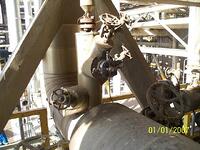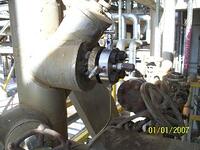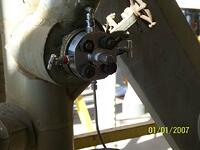Share this
Swagelok Monoflanges: Light, Space-Saving, and Easy to Install
by Katie Dennis on Thu, Jun 20, 2013 @ 16:06 PM
First used in offshore oil rigs, monoflanges are finding more uses on land
 |
|
|
|
|
 |
|
|
Swagelok Monoflange installations at a customer site. |
Here's an example of how the right product can make a difficult job a lot easier.
One of our customers had a reactor vessel and wanted to measure the pressure differential across the catalyst bed at various points. There are several ways to rig an assembly to do that, and Todd Scorah, one of our account managers in Fort McMurray, came up with a couple of designs using combinations of process valves. But the designs were big and bulky. They had to be permanently installed and "the piping guys were rough on them,” says Scorah.
Simple, compact assembly
Talking with the customer about the various challenges, Scorah hit on a different approach: This might be an excellent application for a process monoflange. A monoflange is basically a single, compact assembly that does the job of a more cumbersome grouping of traditional valves. Monoflanges were first developed in the 1980s by Kenmac, a company that Swagelok subsequently acquired, and they take up less space and weigh less than an assembly of standard valves. That made the product a big hit with off-shore oil rigs, where space is at a premium.
You may recall our earlier blog post about VB03 and VB04 process interface valves. The same idea applies here. The monoflange is a light, bolt-on device with a simple design, which reduces leak paths. As more land-based engineers have checked out the advantages of monoflanges, the more uses they are finding.
The monoflange-based device that Scorah suggested was small and light enough to be portable. The customer can bolt it on, take a pressure measurement, unbolt it, and move on to the next point.
The two-piece stem in our needle valves means better performance. As you rotate the handle to lower the stem, the stem rotates as well. In designs that use a single-piece stem, which means the tip of the stem continues to rotate as it makes contact with the seat. That can result in scoring, seizing, or even a weld if a high enough hardness differential is not maintained between the stem and seat. To prevent this Swagelok maintains a hardness differential of Rb 50.
Advantages
Swagelok delivers a design with several advantages and of the highest quality. It takes very little torque to create a seal and hand-tightening is enough, compared to the wrench needed for a traditional gate valve.
Swagelok uses a knuckle joint on the stem to prevent stem rotation. Once the tip makes contact with the seat, it stops turning and simply moves straight down as the handle is turned. This also helps prevent misalignment, which means less worry about leaks.
Factory tested
Every monoflange is tested at the factory to ensure no visible leakage. A shell test is performed at 1.5 times maximum rated working pressure, and a seat test is performed at 1.1 times maximum rated working pressure.
And if you still find yourself comparing an assembly of three big process valves bolted together versus a monoflange, you should consider how much simpler a monoflange is to install, maintain, and that it’s self-supporting. The overall life cycle makes the monoflange a worthwhile option.
You can get specification details for our monoflanges by downloading the catalogue or from the staff at Edmonton Valve & Fitting.
Share this
- Local Services (103)
- Field Advisors (101)
- Training & Events (86)
- Fittings (81)
- Valves (66)
- Resources (62)
- Tubing (62)
- Sampling Systems (60)
- Design & Assembly (57)
- Resources - Downloads (40)
- Hose & Flexible Tubing (39)
- Frequently Asked Questions (37)
- Regulators (34)
- Cost Savings (33)
- Oil & Gas (33)
- Videos (33)
- Steam Systems (29)
- Mechanical Seal Support (17)
- Measurement Devices (15)
- Gas Distribution Systems (9)
- Rentals (6)
- winterization (6)
- Safety (5)
- Covid (3)
- Hydrogen & Clean Energy (2)
- About Us (1)
- April 2024 (2)
- March 2024 (2)
- January 2024 (3)
- December 2023 (2)
- November 2023 (3)
- October 2023 (2)
- September 2023 (3)
- August 2023 (3)
- July 2023 (3)
- June 2023 (2)
- May 2023 (4)
- April 2023 (2)
- March 2023 (2)
- February 2023 (3)
- January 2023 (2)
- December 2022 (1)
- November 2022 (1)
- October 2022 (2)
- September 2022 (5)
- August 2022 (3)
- July 2022 (6)
- June 2022 (4)
- May 2022 (3)
- April 2022 (1)
- March 2022 (2)
- February 2022 (3)
- January 2022 (4)
- December 2021 (4)
- November 2021 (6)
- October 2021 (3)
- September 2021 (5)
- August 2021 (9)
- July 2021 (5)
- June 2021 (7)
- May 2021 (7)
- April 2021 (4)
- March 2021 (3)
- February 2021 (3)
- January 2021 (2)
- December 2020 (3)
- November 2020 (3)
- October 2020 (2)
- September 2020 (3)
- August 2020 (3)
- July 2020 (3)
- June 2020 (3)
- May 2020 (3)
- April 2020 (2)
- March 2020 (3)
- February 2020 (3)
- January 2020 (3)
- December 2019 (2)
- November 2019 (3)
- October 2019 (3)
- September 2019 (2)
- August 2019 (3)
- July 2019 (2)
- June 2019 (2)
- May 2019 (3)
- April 2019 (3)
- March 2019 (3)
- February 2019 (2)
- January 2019 (3)
- December 2018 (2)
- November 2018 (2)
- October 2018 (4)
- September 2018 (2)
- August 2018 (3)
- July 2018 (3)
- June 2018 (2)
- May 2018 (4)
- April 2018 (3)
- March 2018 (3)
- February 2018 (3)
- January 2018 (4)
- December 2017 (1)
- November 2017 (4)
- October 2017 (4)
- September 2017 (4)
- August 2017 (5)
- July 2017 (3)
- June 2017 (4)
- May 2017 (4)
- April 2017 (3)
- March 2017 (5)
- February 2017 (4)
- January 2017 (4)
- December 2016 (3)
- November 2016 (3)
- October 2016 (4)
- September 2016 (3)
- August 2016 (4)
- July 2016 (2)
- June 2016 (2)
- May 2016 (2)
- April 2016 (4)
- March 2016 (2)
- February 2016 (3)
- January 2016 (4)
- December 2015 (4)
- November 2015 (4)
- October 2015 (5)
- September 2015 (2)
- August 2015 (4)
- July 2015 (5)
- June 2015 (2)
- May 2015 (3)
- April 2015 (5)
- March 2015 (3)
- February 2015 (4)
- January 2015 (3)
- December 2014 (5)
- November 2014 (4)
- October 2014 (4)
- September 2014 (4)
- August 2014 (4)
- July 2014 (5)
- June 2014 (4)
- May 2014 (4)
- April 2014 (5)
- March 2014 (4)
- February 2014 (4)
- January 2014 (4)
- December 2013 (3)
- November 2013 (4)
- October 2013 (5)
- September 2013 (4)
- August 2013 (5)
- July 2013 (4)
- June 2013 (3)
- May 2013 (4)
- April 2013 (5)
- March 2013 (2)
- February 2013 (3)
- January 2013 (5)
- December 2012 (3)
- November 2012 (3)
- October 2012 (5)
- September 2012 (3)
- August 2012 (4)
- July 2012 (4)
- June 2012 (1)



